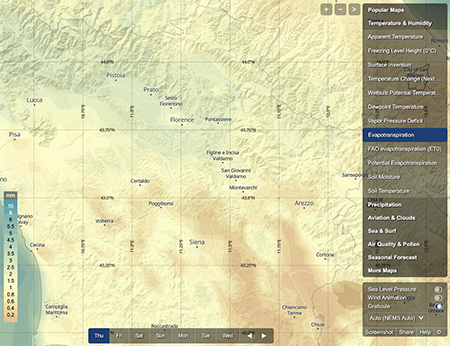In this section, you can find variables that are related to water in the soil and the processes of the evapotranspiration on the Earth's surface.
Soil Moisture
In case of rainfall, water fills the pores between soil particles. Some water seeps down to deeper layers (Gravitational water), some stays in these pores and is therefore also called "retained water". The quantity depends on different soil properties (e.g. pore size, material consistence, organic matter, etc). The amount of the retained water determinates the soil moisture and comprises "Capillary water" (Water in the micropores, the soil solution) and "Hygroscopic water" (very thin films around soil particles, retained so tightly by the soil particles that it can not be taken up by plant roots). Therefore, soil moisture shows the mean moisture of a soil in a specific depth range. It is indicated as volumetric percentage (%), i.e. percent of the total soil volume.
Typical soil moisture is in the range of 15% to 30%, while values greater than 47% normally are not possible, since average soils normally have a pore volume not greater than 47%. On the other side, minimum values are not less than 15%, because water is retained by the smallest pores of the soil ("Hygroscopic water" or "dead water"), even if the soil is very dry.
Evapotranspiration

Evapotranspiration is the sum of evaporation (evaporation over soils, lakes, seas) and transpiration (evaporation from plants). It depends on soil properties (e.g. moisture) and meteorological conditions (e.g. wind, temperature, radiation). Evapotranspiration is expressed in millimeter (mm).
Potential evapotranspiration
Potential evapotranspiration is a theoretical value that indicates how much water would evaporate from a surface with unlimited water availability. Thus, it shows how much water could be evaporated with the total available energy. For instance, the potential evapotranspiration in the Sahara is very high, whereas the actual evaporation is almost zero, because there is no water available. Potential evapotranspiration is expressed in millimeter (mm).
Reference evapotranspiration (ETo)
The so-called reference crop evapotranspiration or reference evapotranspiration, denoted as ETo. The reference surface is a hypothetical grass reference crop with an assumed crop height of 0.12 m, a fixed surface resistance of 70 s/m and an albedo of 0.23. The reference surface closely resembles an extensive surface of green, well watered grass of uniform height, actively growing and completely shading the ground. The fixed surface resistance of 70 s/m implies a moderately dry soil surface resulting from about a weekly irrigation frequency. As a result of an Expert Consultation held in May 1990, the FAO Penman-Monteith method is now recommended as the sole standard method for the definition and computation of the reference evapotranspiration.


